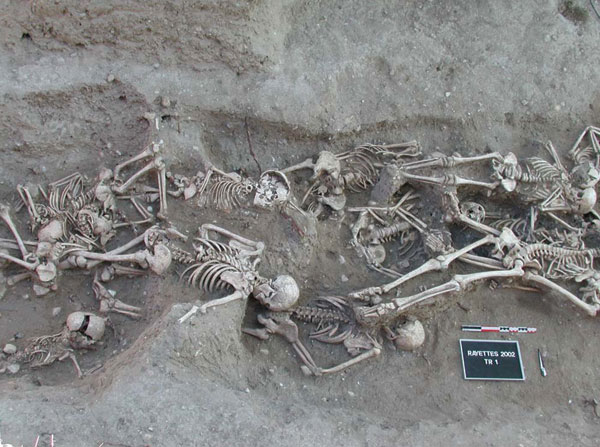During the 1300’s, strong thirsts for power between countries, religious divisions in Europe, and competition for trade routes were common. Trade routes connected the Eastern Hemisphere with the trade of various goods and information, and controlling these trade routes proved to be rewarding. Unfortunately, these trades routes “also likely carried the deadly plague that killed as many as half of all Europeans within seven years, in what is known as the Bubonic Plague.”1
Beginning in 1348, Bubonic Plague infested merchant ships sailing from the Black Sea to Mediterranean ports, causing so much death that it was common for ships to enter European docks and harbors with at least the majority of the crew dead. Despite efforts to prevent ships from reaching land and spreading the disease, the Bubonic Plague made its way ashore. Unfortunately, people found out how contagious the Bubonic Plague was as it swept through Sicily, Italy, and into the rest of Europe. As a result of the virtual inability of people to stop the spread, many suffered and died.

At the height of the Bubonic Plague, it had spread from China to London, devastating entire villages and bringing trade to a virtual standstill. It has been estimated that as many as 200 million people lost their lives as a result of the Bubonic Plague. In fact, it had a mortality rate that varied between regions.2 Although the Black Death was responsible for killing millions of people in Europe, it was a strong force in influencing the structure of power in the Eastern Hemisphere.
Marchione di Coppo Stephani, a chronicler who lived through the ravages of the plague in Florence during the summer of 1348 wrote,
At every church they dug deep pits down to the water level; and thus those who were poor who died during the night were bundled up quickly and thrown into the pit; they then took some earth and shoveled it down on top of them; and later others were placed on top of them and then another layer of earth, just as one makes lasagna with layers of pasta and cheese.3
It not only underlines the crisis for a major European city, generated by the death of tens of thousands of people, but also demonstrates how, even in recording such a profound crisis, a chronicler might evoke a homely, if provocative, image of lasagna.4 People believed that the world was coming to an end. Who was to blame? Other religions, or was it God punishing people for their sins?
As a result of much death and destruction on a scale that people have never seen before, people began wondering if God had been punishing them all along. There was no safe haven for people, even in isolated Russia, for the Black Plague did not hesitate to take any lives—every one was a target.
In the same year [1346], God’s punishment struck the people in the eastern lands, in the town Ornach [on the estuary of the River Don], and in Khastorokan, and in Sarai, and in Bezdezh [at an arm of the River Volga], and in other towns in those lands; the mortality was great among the Bessermens, and among the Tartars, and among the Armenians and the Abkhazians, and among the Jews, and among the European foreigners, and among the Circassians, and among all who lived there, so that they could not bury them [sic]. 5
In fact, religious hatred and persecution was very inhumane and common. With the strong belief that other groups were responsible for the Plague, the methods involved in persecuting other religious groups were cruel. Some common examples were: burning, stoning, decapitation, and exile.
The Black Death was devastating. It had killed millions of people across Europe and Asia. Anarchy, fear, and insecurities dominated the landscape in Europe during the 1300’s.[ 5. Sharon N. DeWitte, “Age Patterns of Mortality During the Black Death in London, A.D. 1349–1350,” Journal of Archaeological Science 37, no. 12 (December 1, 2010): 3394-3400, https://www.ncbi.nlm.nih.gov/pmc/articles/PMC3094018/ (accessed October 12, 2016).]
- Andrew Lawler, “How Europe Exported the Black Death,” Science 352, no. 6285 (April 29, 2016): 501–2. ↵
- Encyclopedia Britannica, February 2015, s.v. “Black Death.” ↵
- Marchione Di Coppo Stefani, “The Florentine Chronicle,” 1903-1913, accessed, October 18, 2016. http://www2.iath.virginia.edu/osheim/marchione.html. ↵
- John Henderson, “Debating Death and Disease,” History Today 64, no. 4 (April 2014): 58–59. ↵
- Celestine Bohlen, “Diphtheria Epidemic Sweeps Russia,” The New York Times, January 29, 1993, sec. World, http://www.nytimes.com/1993/01/29/world/diphtheria-epidemic-sweeps-russia.html. ↵



76 comments
Cesar Zavala
I had just finished reading another article on here about the bubonic plague which only gave a brief view of how the epidemic occurred. I am glad to have also read this article on the plague because it had more information on how and where the plague traveled. Lost of great facts along with great pictures. Keep it up!
Nelson Smithwick
The quote by Marchione di Cappo Stephani really paints a vivid image of the amount and frequency of deaths caused by the black plague, people must have been terrified knowing that they or any of their friends or family could die at any time and be shoveled into one of those mass graves. Thankfully we have not had to face any epidemics even remotely similar to this since the Spanish flu in the early 1900s.
Lianna Ybarra
I learned about this in HS World History and found it so interesting! It is crazy how one plaque killed millions of people and they couldn’t stop it. I never looked into the reasoning though as to why it happened. It’s interesting to think that they thought this was God’s way of punishing them. Very good article though, I’m glad you picked this topic!
Aaron Mcglown
I found it surprising that the plague influenced the structure of power in the Eastern Hemisphere. It crazy to think that a disease like the black plaque would cause so much chaos between nations and religious groups. The plaque killed so many people and is a big point in history and you showed that in this article. good job!
Hayden Hollinger
This was a very well written article! I found this article to be very informative and I now have a strong understanding of the Black Plague. It is shocking and difficult to even comprehend the amount of lives that were lost as a result of the plague. I also found it surprising to read that the plague even influenced the structure of power in the Eastern Hemisphere.
Aimee Trevino
Really informative article! It is scary to read about the black plague, because to think of how these people were living, and never knowing if they would get sick. Even worse is seeing that not only was the plague killing people, but also people killing other people believing they were the cause of the epidemic. Overall I really enjoyed this article, well done!
Zaraly Frasquillo
I remember reading about the Bubonic plague in high school and honestly my mouth dropped. I find it insane how much of the worlds population died because they were not immune to it. I remember in 2015 there were fifteen cases in the United States of people infected with the Black plague, but only four of them dying. Although the Black plague caused a lot of pain and deaths I personally feel that without it no one would have cared to make medicines, and people would not have been interested in trying to understand what happened.
I think you did an amazing job in writing this article, it was very informative and especially the lasagna reference, it was definitely my favorite part. Great job!
Bailey Rider
I thought this was a very well written and informative article! I love reading about and learning about the bubonic plague. It’s crazy to me, especially in our modern time, to think that a disease could wipe out so much of a population. I like that you touched on the fact that the plague brought around a change in the power structure in Europe and I also thought it was interesting that the different religions blamed each other for the plague. Thank you for this informative article!
Mariana Govea
Great informative article! Wow its so sad to read about these certain types of issues that our world faced at one time, the black plague was like no other taking many innocent lives! I remember talking about this in my world history class back in high school and how we talked on how much an impact it had on our world population! And it is so sad to think that now days we take healthcare and many cures fro diseases for granted, when back in the day when this was at its peak people would have wished to at least have something to put the pain at ease! As well as it is crazy to analyse these events and how people acted towards them, how they believed it could have been the end of the population if the disease didn’t stop from spreading but we managed to over come it! Great way for scientist to evaluate the way people act during and after big disasters like these!
Nicolas McKay
This is an amazing article. The black plague was truly a disease unlike any other. Trade was such an important aspect of society back then and continues to be this day. Yet the very trade routes they so depended on were what helped spread the plague as far as it did. It makes you wonder if there was anything they could have done to prevent such a huge tragedy.